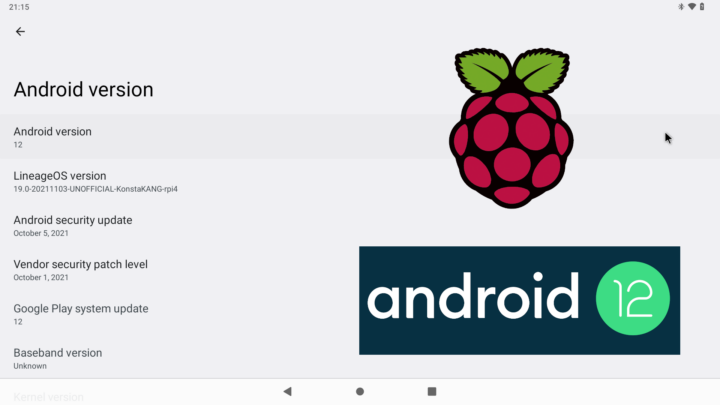Android 12 (AOSP) source code was released last month, and a developer took the opportunity to port Android 12 to the Raspberry Pi 4 single board computer and derivatives.
More specifically, KonstaT created an unofficial build of LineageOS 19.0 for Raspberry Pi 4, Raspberry Pi 400 keyboard PC, and Compute Module 4 working on systems with at least 2GB of RAM.
While it’s reserved for advanced users, the Android 12 build appears to work pretty well with most features supported including:
- Video
- HDMI display including CEC
- Touchscreen/multi-touch (USB touchscreens, Waveshare SPI touchscreens)
- Hardware-accelerated graphics (V3D, OpenGL & Vulkan)
- Audio
- HDMI, 3.5mm jack, USB microphones, Bluetooth speakers/headphones
- Audio DACs such as Hifiberry DAC+
- Connectivity
- Ethernet
- WiFi including tethering
- Bluetooth including Bluetooth tethering
- GPS using external USB modules
- USB tested with
- USB mouse, keyboard, storage, etc…
- USB-C: ADB, MTP, PTP, USB tethering
- I/Os (GPIO, I2C, SPI) tested with
- Remote controls via external GPIO IR modules such as TSOP4838
- RTC using I2C modules like DS3231
- I2C sensors, e.g. MPU6050, LSM6DS3, LSM303DLHC & BME280/BMP280 accelerometer/gyroscope/magnetometer/temperature/pressure/humidity
- Serial console via USB to TTL board
- SPI touchscreen (see Video section)
The only main known issues so far are the lack of hardware video decoding & encoding and the Pi camera does not work. It’s still possible to use software video decoding and encoding, but obviously the resolution/framerate may be limited, and USB UVC webcams using MJPEG should also work, but it’s not been tested yet. SELinux is also in permissive mode, so this test image should not be considered secure, and they should be various issues that may have not been found by users.
Since the image includes parts that are licensed under a Creative Commons Attribution-NonCommercial-ShareAlike 4.0 International). license it can be used freely for personal and educational use, but not commercial use. KonstaT posted some information on XDA Developer forums, but you’ll find more information including the link to the image, the kernel source code, as well as instructions to install Magisk and support for Google apps on KonstaKANG.com.

Jean-Luc started CNX Software in 2010 as a part-time endeavor, before quitting his job as a software engineering manager, and starting to write daily news, and reviews full time later in 2011.
Support CNX Software! Donate via cryptocurrencies, become a Patron on Patreon, or purchase goods on Amazon or Aliexpress





